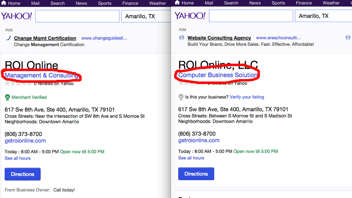How To Successfully Start Or Restructure A Business During COVID-19
If you’re anything like me, you’ve likely been bombarded with ads lately promising to help you start your online business or help you get tons of new clients. You may have been tempted to buy into these courses in order to start making money on your own terms.
But there are a few things you should know before starting a business or pivoting the one you have.
Though now is actually a great time to start a business, about half of all businesses do fail. And advice from the internet can be spotty at best.
For example, the resulting advice from searching for “how to start a business” yields vague, unhelpful lists rather than actual strategies:
- Conduct market research
- Write a business plan
- Choose a business structure
- Register your business
- Pick your business location
These are nice items to put on your to-do list, but they don’t actually help you understand the ins and outs of what it means to create and run a business people want to buy from. In fact, they can make you even more confused and frustrated.
So how can you transform your dream of owning a business into reality? And how can you ensure your new business or new business approach will survive the changing economy?
Start by taking a closer look at the big picture, the heart of your business, and ignore all the little details getting in the way of your success.
Understanding The Heart Of A Business: The Three P’s
At its most basic, a business is comprised of what’s called The Three P’s: people, process, and product. Donald Miller adds a fourth P, positioning, which is where marketing fits in.
So, before you enroll in a course, register an EIN, or invest money in a website that doesn’t help you, you need to get really clear about who you’re serving, what problem you’re solving for them, and how you’re helping.
Because at its core, your business is a way to earn profits by solving a problem (process) for a customer (people) through a product or service (product). Then marketing (positioning) it effectively so that it’s found by the right people.
Though it might be more fun choosing a business structure or picking your business name or redoing your website, doing so before you’re clear on your 3 P’s is a waste of time (no matter what the internet says).
A much simpler starting point for creating a business is to first consider who you’re helping, what you’re doing for them, and how. ROI Online calls incorporates this into the clear messaging portion of their Business GrowthStack framework, by the way.
So let’s start with people. To get a deeper understanding of your people, create a buyer persona. Then create a StoryBrand BrandScript around that persona. Personas are semi-fictional representations of your ideal customer based on hard data. If you’re just starting out, you may not have a previous customer list to base your persona off of, so consider a future competitor’s customers and use them as reference.
The BrandScript helps you get a deeper understanding of the customers’ emotions, which is key to creating marketing that works. It also helps you know exactly why they care about what you’re selling, an essential tool for making sales.
Next, let’s move onto process. A business is made up of dozens of processes working in harmony. If one or two (or all) of those processes aren’t well-thought-out, you could have serious issues further down the road. The most important processes to consider here are your sale process, production/distribution process, and communication process.
A system like a CRM provides your sales team with the tools they need to create and follow an effective process. That way, everyone doesn’t contact the same lead multiple times. You might consider a system like EOS or Agile to improve communication, keep your company culture healthy, and make sure projects are done on time. For many businesses, the only way to know if your process will work is to try it. Re-evaluate in a few months to see how the process worked in action.
Product is the easiest P to address. Chances are, you’ve been dreaming about selling this product or service for years. You know it inside and out: how it works, why it’s different. And that’s ultimately the key to a successful product. Before you launch, make sure you haven’t overlooked any fatal flaws, and ensure that the product really will solve your customers’ problem as it claims.
Tips for success: if you’re struggling, you can always channel your inner Don Miller and use what you know from story to start with a problem you want to solve and build off that.
Your business strategies might change in the future. You might get different tools or have to deal with a pandemic and ever-changing social landscape, but remembering the core of who you help—of your people, process, and product—will help keep you on track to succeed no matter what happens.
The Fourth P: Where Marketing Comes Into Play
The truth is, no one will care about your business unless you give them a reason to. You do that using marketing.
HubSpot defines marketing as the process of getting people interested in your company's product or service. It’s at this stage that market research becomes necessary. And it’s here when your understanding of who your customers are and what problems you’re solving for them matters most.
Marketing isn’t social media. It isn’t going viral or your website or commercials, or even branding. Marketing is taking all Three P’s to define your company and using that to tell other people about it.
It’s letting people know you exist in a way that makes them feel safe and understood, in a way that makes them want to do business with you.
It’s building trust and making long-lasting connections.
How you tell the world about you is up to you. You can use social media, a website, SEO, video, whatever tools move the needle forward and results in dependable, repeatable ROI. But you do so using an effective strategy that applies to every other stage of your business: product creation to sales and back again.
Because marketing is your company.
Don’t believe me? What about Seth Godin?
We’ve seen a lot of marketing strategies over the years, and the only ones that have stood the test of time are strategies built on the Business GrowthStack. These include four components that work together to create a persuasive yet comfortable experience for customers: clear messaging, campaigns, marketing automation, and sales automation.
You can go many different routes to create these four components, but as long as they’re consistent and clear, you’ll get the results you want from your marketing.
Implementing The P’s For Yourself
Figuring out who you serve, the problem you solve, what you offer, and how you position it is easy to do using tools like the StoryBrand.
ROI helps companies every day figure out their Three P’s and helps them come up with effective marketing strategies to position themselves in the marketplace.
See what we can do for you.





